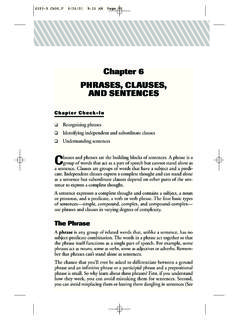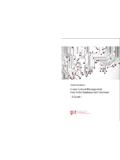Transcription of Modal and Perfect Tenses - TAMIU Home
1 Updated 7-30-12 Modal and Perfect Tenses Past Modal Perfect tense is used when it is unknown if the subject performed an action in the past, but it s possible, necessary, or likely. The past Modal Perfect tense begins with any past tense Modal (could, should, would, might) followed by have, plus a past tense action verb (regular verbs ending with -ed and many irregular verbs ending with -en). For example, The bride would have landed on the The bride s maids should have seen Gloria on the Write the correct form of the action verb in parenthesis in the blank. Could have (select) _____ Should have (got) _____ Might have (rise) _____ Would have (scrub) _____ Could have (inspect) _____ Should have (keep) _____ Present Modal Perfect tense is used when it is unknown if the subject performed an action prior to some designated point in its future OR past, but it s possible, necessary or likely that the subject will or did.
2 A present Modal Perfect tense begins with any present tense Modal (will, may, shall, must) followed by have, plus the past tense of the action verb (regular verbs ending with -ed and many irregular verbs ending with -en ). For example, Gloria may have torn her wedding dress. May have (wiggle) _____ Shall have (sneeze) _____ Will have (beat) _____ May have (sell) _____ Shall have (shrink) _____ Past Modal progressive tense is used when it is unknown if the subject is in the process of performing an action, but it s possible, necessary or likely. The past Modal progressive tense begins with any past tense Modal (could, should, would, might) followed by be, plus the -ing form of the action verb. For example, The fight might be ruining the entire evening.
3 Updated 7-30-12 Modal and Perfect Tenses Should be (swoop) _____ Might be (embarrass) _____ Would be (weep) _____ Could be (sweat) _____ Present Modal progressive tense is used when it is unknown if the subject will be in the process of performing an action OR plans to take an action at some point in the future, but it s possible, necessary or likely that he is or will. Present Modal progressive tense begins with any present tense Modal (will, may, shall, can, must) followed by be, plus the present participle -ing form of the action verb. For example, The burly young man must be thinking of his senior prom. Will be (sneer) _____ May be (imbibe) _____ Shall be (demonstrate) _____ Can be (sting) _____ Must be (split) _____ Past Perfect progressive tense is used to indicate that at some point in the past, the subject was in the process of performing an action, but the action is over.
4 The past Perfect progressive tense begins with had followed by been, plus the -ing form of the action verb. For example, Gloria had been planning this wedding for a long time. Had been (answer) _____ Had been (observe) _____ Had been (set) _____ Had been (hold) _____ Had been (forgive) _____ Present Perfect progressive tense indicates that at some point in the past, the subject began performing an action, and the subject continues to, even up to the present, to perform the action. The present Perfect progressive tense begins with has (singular) or have (plural) followed by been, plus the -ing form of the action verb. For example, Updated 7-30-12 Modal and Perfect Tenses Ren has been puzzling over the look on Gloria s face ever since the burly young man arrived.
5 Circle has, have, or had depending on which one agrees with the subject. Also, write the correct form of the verb in parenthesis. Roy (has/have/had) been (lie) _____ Singers (have/had/has) been (disagree) _____ She (has/had/have) been (catch) _____ The guests (have/has/had) been (arrive) _____ They (have/has/had) been (switch) _____ Write two sentences for each of the following that use the verb tense indicated and an action verb of your choice. Use a different action verb in each sentence. 1. Past Perfect progressive (had + been + -ing) 2. Past Modal Perfect (could/would/should/might + have + -ed or -en) 3. Present Modal progressive (will/may/shall/can/must + be + -ing) 4. Past Modal progressive (could/would/should/might + be + -ing) 5. Present Perfect progressive (has/have + been + -ing) 6.
6 Present Modal Perfect (will/may/shall/must + have + -ed or -en)



















